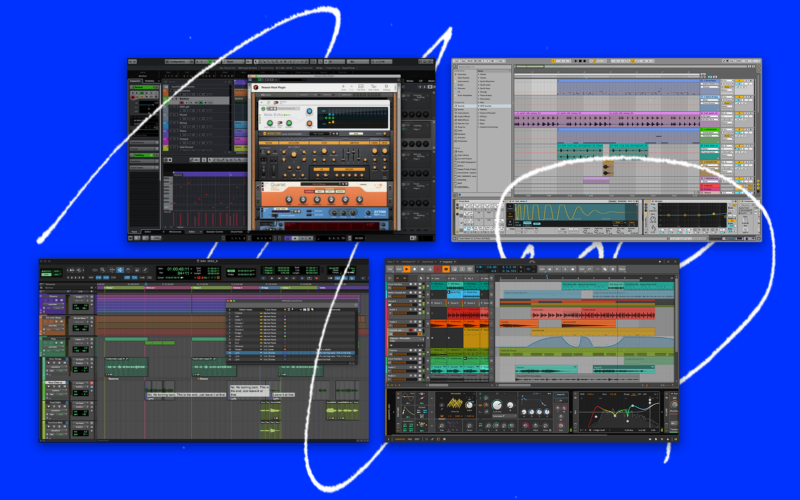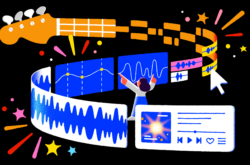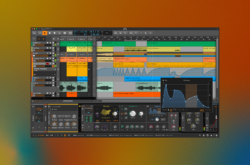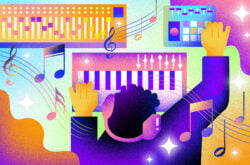Digital audio workstations are essential to most music producers today, either fully replacing or dynamically enhancing physical recording tools.
The shortened name, DAW, is a term that may not necessarily be familiar for many musicians or fans. In particular, creatives who don’t produce their own music or use software instruments may rarely hear it, despite the DAW’s central position in modern music history.
In this article, we take a look at what a DAW is, explore their rich history, and discuss how to choose one that’s right for you.
Let’s dive in!
What is a DAW?
As implied by the word ‘workstation,’ a DAW is a software product that provides a space to create music. Their interfaces enable the recording, playback, editing, and exporting of audio files.
With DAWs, music creation can live fully ‘in the box,’ meaning all composition and synthesis is digital from start to finish. That said, they can also capture analog signals, like one’s voice via a microphone, using an external interface and built-in software that converts that performance to a digital record.
Nearly every modern record will utilize at least one DAW, directly or by extension of how samples or other components were captured, mixed, and mastered. Unlike the early days of analog recording, which required expensive and often bulky machinery, DAWs call for nothing but a computer to get started. We can therefore credit the development and industry adoption of these products as a primary driver for DIY music production.
A brief history of DAWs
The invention of the DAW is closely tied to that of MIDI data, as well as a number of talented, forward-thinking German developers and musicians. Yes—to those reading who can name a few of the most popular DAWs in the world, also founded in Germany—the very roots of the digital audio workstation also began there.
MIDI data is a computer language which represents musical expression. But how valuable is this without a place to live and breathe? Enter Steinberg Research, founded in 1983 with the intention of formulating the first computerized MIDI sequencing system. Following a number of basic iterations, the foundation was built for one of the big players still around today in Cubase.
We can trace back the roots of Logic, acquired by Apple in 2002, to this same time period. Two years after this acquisition, GarageBand was released to be included in the software package with every Mac, which was a major step in the accessibility of digital music-making tools that solely require a computer to get started. Apple was not the first, however, as the free, open-source program Audacity was released four years prior (and also remains a staple today).
There’s so much more to this story, so if you’re interested, we recommend exploring it further via articles like this one by our friends at MusicRadar.
Why haven’t I heard the term before?
Even when we look at the software companies developing these workstations, or the music industry giants actually marketing the music made through them, the term ‘DAW’ is rarely found in public-facing copywriting. Ableton’s website brands themselves as ‘creative tools,’ and their core DAW page currently makes no mention of the term. BitWig and Pro Tools reference the shortened name a few times, but neither ‘DAW’ nor ‘digital audio workstation’ can be found in the info pages of Logic Pro, Reason, Cubase, or FL Studio either.
Then, we look at how we write about music itself, for musicians and fans alike. It’s not unusual for an album review to mention the producer or studio, explore technical details about the instrumentation and the mix, and even recording techniques or audio effects that are central to a DAW. The workstation, however, is rarely seen in such reviews, as again, it’s an industry term at its core.
There’s a clear aversion to using a phrase that may be confusing to readers, or in the case of software companies, their customers. After all, FL Studio’s promise to provide ‘the fastest way from your brain to your speakers’ is quite enticing in comparison to something like ‘a workstation for digitized audio.’ Marketing teams across the industry have made it clear that emphasizing inspiration is more effective in distinguishing themselves than using a slightly-awkward sounding acronym like DAW—and that’s perfectly understandable, though as a new producer, it’s natural to wonder why this is.
How to choose a DAW
We’ve already mentioned many of the most popular DAWs out there, ranging from completely free options to those used to pump out Top 100 hits each month. When choosing your first DAW, budget is certainly one of the first things to establish. Many offer trial periods to help you make an informed decision before dropping hundreds, or in rare instances even thousands, on a license. Alternatively, you can explore our options to rent-to-own on Splice, which could allow you to more deeply test multiple DAWs or work towards ownership without breaking the bank.
Once you have a sense of your budget, ask yourself what you want to make and what tools (virtual and physical) you’ll use to make music. If you’re an aspiring beatmaker who will rely heavily on samples, your needs in a DAW may be different than if you’re recording vocal ensembles or full bands. For example, certain programs like Pro Tools are frequently considered to be well equipped for the latter, more traditional recording environment. Many studios around the world pair their Pro Tools license with a large physical board and a rack of compressors, EQs, and more. That said, also note that as of 2022, Pro Tools operates solely on a subscription basis. They remain to be one of the only major DAWs to do so, alongside companies like Adobe that are known for this across their entire Creative Cloud.
Meanwhile, other programs emphasize, or were even founded, with live performance in mind in addition to traditional DAW features. Leading workstations like BitWig Studio and Ableton Live lean heavily into a non-linear interface. By allowing you to record and modulate clips of audio or MIDI on the fly, these DAWs emulate the feeling of collaborating with another musician, with the ability to quickly improvise, loop, and expand your ideas. DAWs like Ableton are crucial to artists around the world who embrace incorporating live or pre-recorded loops, beats, and other electronic elements into their performances.
Ultimately, there’s no universal answer for what’s the best DAW, and the truth is that the most popular features are shared across workstations in one way or another, and you can make great music in any one of them. What’s important is that you identify what your budget is, and ask yourself what niche needs or preferences you may have—from there, you should be able to narrow down to a workstation that’s the best fit for you.
The future of DAWs
DAWs continue to evolve as new technology emerges. What began as a basic interface to make sense of digitized audio has expanded to an incredible toolkit for creative extension and endless inspiration. While not discussed here, the adoption of VST (virtual studio technology) and MPE (MIDI polyphonic expression) have proven how these tools can continue to be reimagined.
It’s an incredibly exciting time to make music, as the relationship between the player and the tool morphs and tests boundaries. We invite you to jump in, no matter your experience or budget. As Splice CEO Kakul Srivastava recently shared on Dan Runcie’s Trapial podcast, the idea of being a musician, and particularly not being good enough, continues to limit us. That emotional barrier to entry to making music is real, while for example, not being ‘good enough’ to be a professional photographer doesn’t stop all of us from taking photos.
Why not hop onto a free audio tool to start, including new options like Splice Create, and take a few photos? At worst, you close the window or delete the file before trying again.
Try leading DAWs for free, and then Rent-to-Own them until they’re yours:
October 20, 2023



